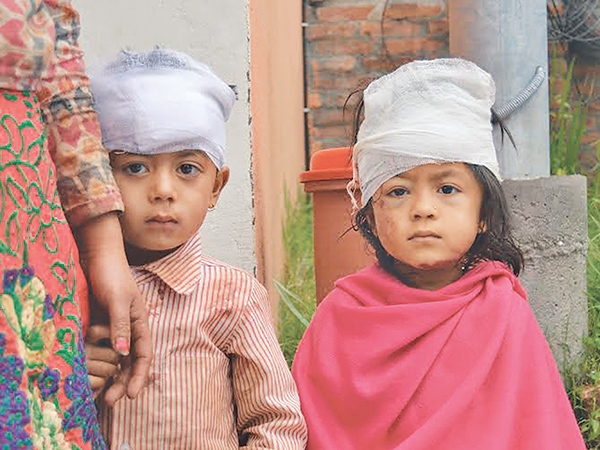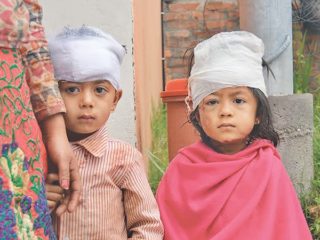From The Kathmandu Post (08 May, 2015)
State and society will come together for national reconstruction, others must support
Those who miraculously survived the fall from Dharahara tower on April 25 recall a stiff breeze at the top. My brother, hiking on Champadevi Hill to the south, felt the shaking earth and then his heart stopped as he noticed the dust billowing out of the ancient inner cities. His photographs catch the wind carrying the dust westward. Dharahara was standing one moment, it was gone the next.
The minar was never an attraction for Western visitors, but it has been held close by the citizenry, especially those from the districts. Historically, Dharahara represented the resplendent Valley, and was a symbol of the state; in the modern era, it became a viewing platform as the tallest structure in the country, a ‘spire of identity’ with much emotion attached to it.
Like the temples, palaces, and neighbourhoods all over, Dhrahara had fallen before this and been rebuilt. There has always been the historical certitude that another great earthquake will come, and we will reconstruct and recover.
Mud mortar
At the Dharahara site, as elsewhere, it was the independent citizens who were understandably the first to respond. With whatever implement available, if not bare hands, they dug the injured and dead out of the rubble, waiting for the police and army to arrive. At Patan’s heritage Durbar Square, the neighbourhood youth organised immediately to protect the fallen gods, wooden struts, and bronze artefacts, and then handed over charge to the Department of Archaeology, municipality, and security personnel.
What was most significant about the Great Earthquake of 2015/2072 was how it hit the poor of town and country, as well as the heritage sites. This seemed mainly because the quake’s peculiarity—in terms of duration, directionality, and depth of geological rupture—was to destroy buildings that used mud mortar as binding agent.
We were saved from a larger disaster because the cement pillar-and-beam buildings mostly withstood the swaying. But whole hamlets and neighbourhoods of rock/brick and mud mortar construction were flattened, from Gorkha to Dolakha, taking in Nuwakot, Rasuwa, Sindhupalchok, Dhading, Kavre, and the three Valley districts. The rebuilding of habitations by the tens of thousands and schoolhouses by the thousands thus becomes the goal and challenge.
Per-capita goodwill
The government’s response was disastrously sluggish in its weakness in coordination, there for all desperate citizens and international community to see and remark upon. In the meantime, the political party leadership seemed to go into hiding for two whole weeks, after having been in the media limelight non-stop for a decade and more. The ‘sirsasta’ even left the party rank and file to fend for themselves amidst the wrath of the people.
There seemed to be a void at the top, while at the bottom, there was the absence of elected and accountable local government office-holders. What added to the tragedy was that the traditional and clan institutions have weakened under the onslaught of modernisation, families have become atomised, and too many young adults are away as job migrants in India, Malaysia, and the Gulf.
Among the mistakes made by the government was the disastrous Rastra Bank circular that all relief contributions be directed to the Prime Minister’s Disaster Relief Fund. This showed a lack of appreciation for how much Nepal is held in regard all over the world, to tap which the Fund should never have been proposed as a monopoly receptacle.
Nepal is fortunate to be a country that has (this writer’s claim) the highest per-capita goodwill worldwide. And this is the time to tap into that pond so that the individualised support from hundreds of thousands of well-wishers from all over goes in a variegated way to the hamlets and tols, beyond the support of the international organisations that will have to go through the government.
The mistake was corrected after a few days, but it showed a lack of understanding of Nepal’s standing in the world. The governmental sluggishness also meant an inability to coordinate the immediate and generous support of the international community (which continues to pour in).
Terminal cynicism
In lambasting the governmental response, however, one must guard against terminal cynicism. Let us try and keep some perspective—this is polity that has barely gotten back on the democratic rails, after the November 2013 elections. Nearly two decades of conflict, followed by political disarray, have weakened the parties and bureaucracy, and the response of the civil society ‘stalwarts’ has hardly been exemplary. We all know why we happen to be where we are, which helps explain why the immediate response to the earthquake was what it was.
The appropriate attitude would be to organise to challenge this elected, democratic government to deliver, rather than wish its collapse. Civil society as well as the international community must work with and monitor the state institutions at this stage, so that people’s need for reconstruction and long-term governance through efficient governmental mechanisms is supported.
Indeed, introspection need hardly be limited to governmental functionaries. Each of us, for example, can ponder over our attitude towards elections to local bodies, which have been sabotaged for a full dozen years now. How come we have been so ineffective, even if we made the call, so that when the time came for rescue, relief, rehabilitation, and reconstruction, there were no elected, accountable office-holders in the villages, districts, and municipalities?
Constitutional stability
Besides the communitarian spirit of citizens on the ground, what burst forth this time around was the presence of young adult professionals, who came together, organised, and fanned out across the destroyed valleys, making up for the inadequacies of government and big-name NGOs and INGOs. This spontaneous spirit of capable and committed voluntarism gives reason to hope that reconstruction will happen with competent and diligent civic monitoring.
To count further blessings, the Great Earthquake actually saved us from a greater calamity by the day and time that it struck—imagine if it had happened at night or on a weekday. The airport’s single runway did not succumb to liquefaction, the highways remained functional, cement-and-concrete buildings mostly stood. There was no fire in a city populated by gas cylinders.
To give the state administration its due, there was no looting, the electricity did come back ere long, the cell phone networks held, engineers went in to certify building safety, and there has been a step-by-step return towards normalcy. About 800,000 departed the Valley in orderly fashion within a span of three-four days. There must have been something working here, and it must be the drive and sense of duty of individual administrators, bureaucrats, and security force personnel.
Looking beyond rescue, relief, and rehabilitation and towards national reconstruction, the public desperately seeks constitutional stability. Let us have whatever is feasible after eight years of trying, a new constitution or regularisation of the Interim Constitution; incorporating agreed provisions, leaving federal delineation to an accountable, empowered commission if there can be no agreement due to existing societal divides. Let us recognise a deadlock when we see it, and skirt around it.
A date for local elections must be announced for early autumn 2015, so that the important task of rebuilding in town and country can proceed under accountable, elected representatives rather than the leaky ‘all party mechanisms’.
The task of reconstruction will have to prioritise the rebuilding of schools, the promotion of temporary housing that can take the victims through the monsoon and winter, and permanent housing according to climate, location, and terrain. The restoration of the heritage sites is important for the spiritual and mental wellbeing of the populace, for being the base for intangible culture, as a mark of respect to ancestors and history, and, lastly, for the economic opportunities they represent.
In future, we must seek to ensure that there is a civic response to calamities, rather than a reliance on national and international militaries and paramilitaries, though their involvement has been critical. Such a civic response, and also an instinctive collaboration between state and society, was evident at Dhulikhel Hospital, which became the staging ground for the region east of the Valley.
At Dhulikhel, one saw heartening coordination between the hospital community, the local administration led by the Chief District Officer, the Armed Police, the Army, the Nepal Police, and community activists. Said Dr Ramkant Makaju Shrestha, founder of the hospital, “This is a war without enemies, which means half the battle is already won. If we work without acrimony and one-upmanship, we will achieve national reconstruction.”
